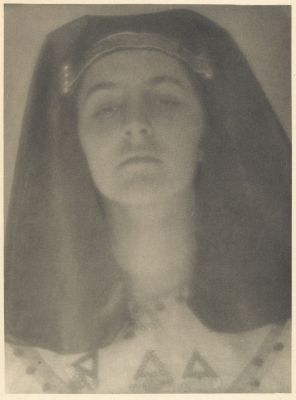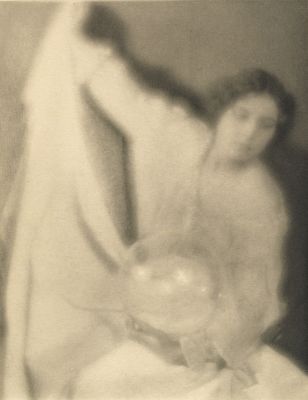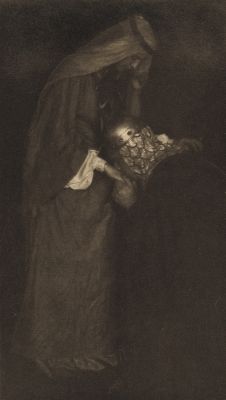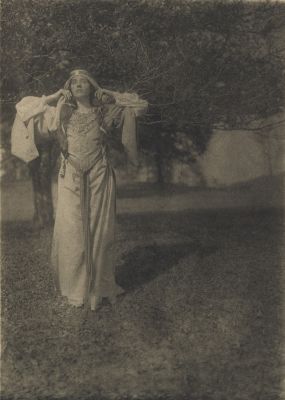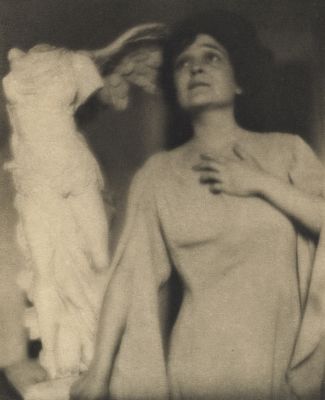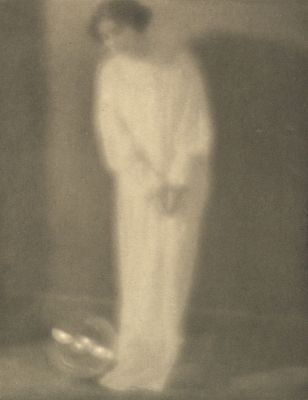
Title
TorsoArtists
Stieglitz, Alfred (American, 1864-1946)Key FigureWhite, Clarence H. (American, 1871-1925)Publication
Camera Work XXVIIDate
1909Process
PhotogravureAtelier
Manhattan Photogravure Company, NYImage Size
21.3 x 16.1 cm
Both Clarence Hudson White and Alfred Stieglitz were founding members of the Photo-Secession in 1902, based in the New York City area, and it was during this period that the two became close friends and collaborators. They shared a deep reverence for Pictorialism, which White pursued most notably through his painterly images of family members and intimate friends. Atmospheric portraits were his forte and were greatly admired by Stieglitz, who reproduced them regularly in the early issues of Camera Work.
In 1907, White and Stieglitz collaborated on a series of experimental works ostensibly to test lenses as well as new photographic plates and printing processes. The idea developed in consequence of various lively discussions with some painters about portrait painting and the impossibility of the camera to do certain things. Challenged, the two photographers resolved to disprove the painters’ theories. Two models from among their friends and acquaintances were asked to participate: a young woman named Mabel Cramer and a second woman known to history only as Miss Thompson.
The resulting images, purported to be sixty negatives produced over a two week period, are more visually aligned with White’s aesthetic and were likely printed by him; it is believed that Stieglitz served mainly as an advisor. The portraits, both clothed and nude, range from demure and closely cropped to more classical, full-length depictions alongside visual props or within carefully staged scenes. While the pair exposed approximately sixty negatives, only a handful of physical prints were made. (Christies)
Reproduced / Exhibited
Coville Photographic Collection : an Annotated Checklist. Detroit?: The Foundation, 1997. p.20
Frizot, Michael. New History of Photography. Place of publication not identified: Pajerski, 1999. Print P. 321
Doty, Robert M. Photo-secession: Photography As a Fine Art. N.Y: Eastman, 1960. plate VI.
Erwin, Kathleen A. Pictorialism into Modernism: The Clarence H. White School of Photography : Photographs from the Coville Photographic Art Foundation and Warren and Margot
Ewing, William. The Century of the Body: 100 Photoworks 1900-2000. Thames and Hudson Ltd, 2000. p. 18
Fulton et al., Pictorialism into Modernism: The Clarence H. White School of Photography, Rizzoli, New York, 1996, p. 20.
Gernsheim, Helmut. Creative Photography. Aesthetic Trends 1839-1960. [with Illustrations.]. London: Faber & Faber, 1962. p. 98
Jonathan Green, Camera Work: A Critical Anthology, Aperture Inc., New York, 1973, p. 151.
Greenough, Sarah, and Alfred Stieglitz. Alfred Stieglitz: The Key Set : the Alfred Stieglitz Collection of Photographs. Washington, D.C: National Gallery of Art, 2002. Pl 327
William Innes Homer, Alfred Stieglitz and the Photo-Secession, Little Brown & Co., Boston., 1983, p. 77.
Kruse, Margret. Kunstphotographie Um 1900: D. Sammlung Ernst Juhl; Hamburg: Museum für Kunst u. Gewerbe, 1989 pl. 904
Rosenblum, Naomi. A World History of Photography. New York: Abbeville Press, 2008. no. 407
Whelan, Richard. Alfred Stieglitz: A Biography. , 1997
Exhibited Ithaca, New York, Herbert F. Johnson Museum of Art, Cornell University, An American Portrait: Photographs from the Collection of Diann and Thomas Mann, April 1–June 12, 1994, no. 43.
